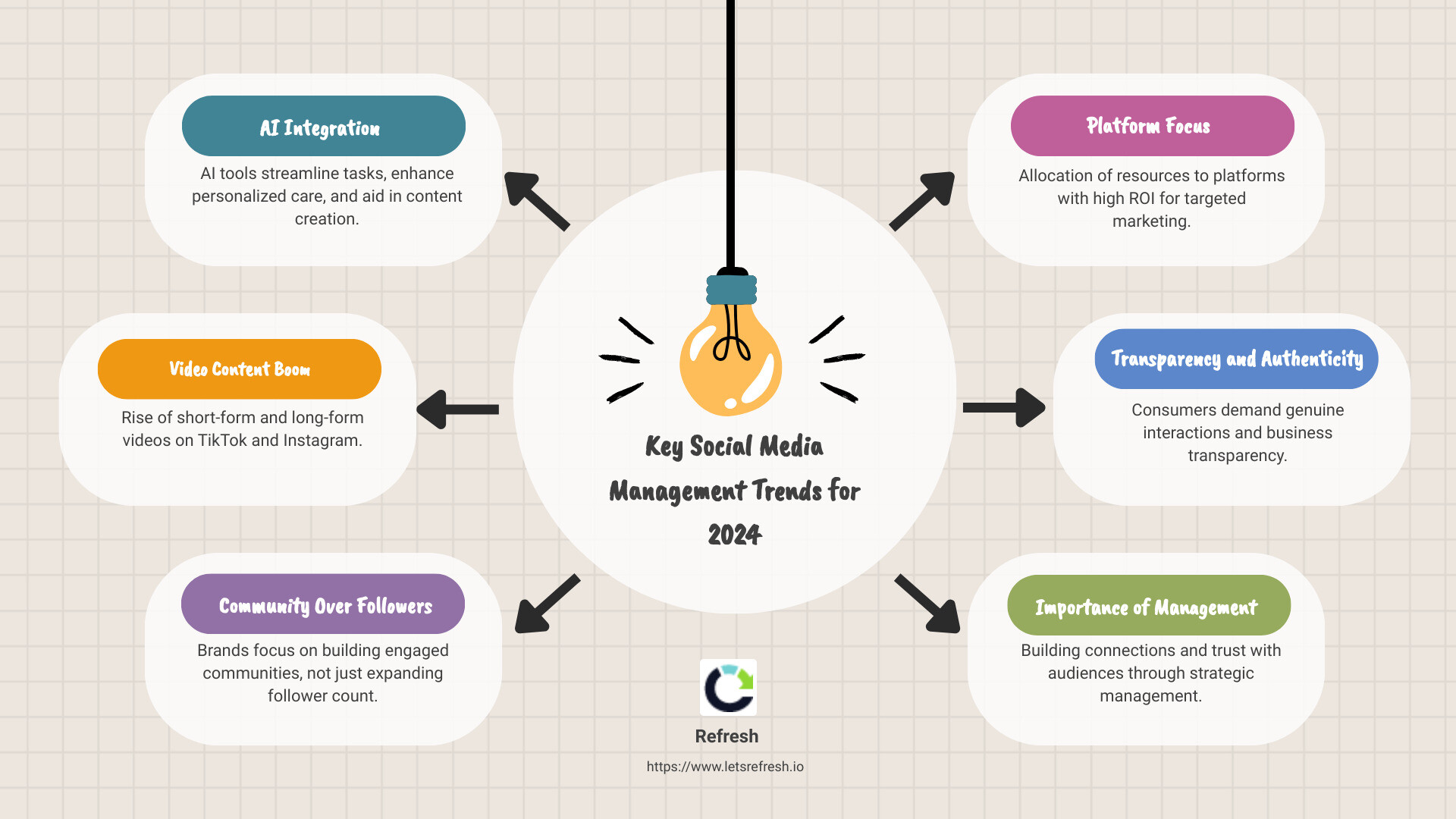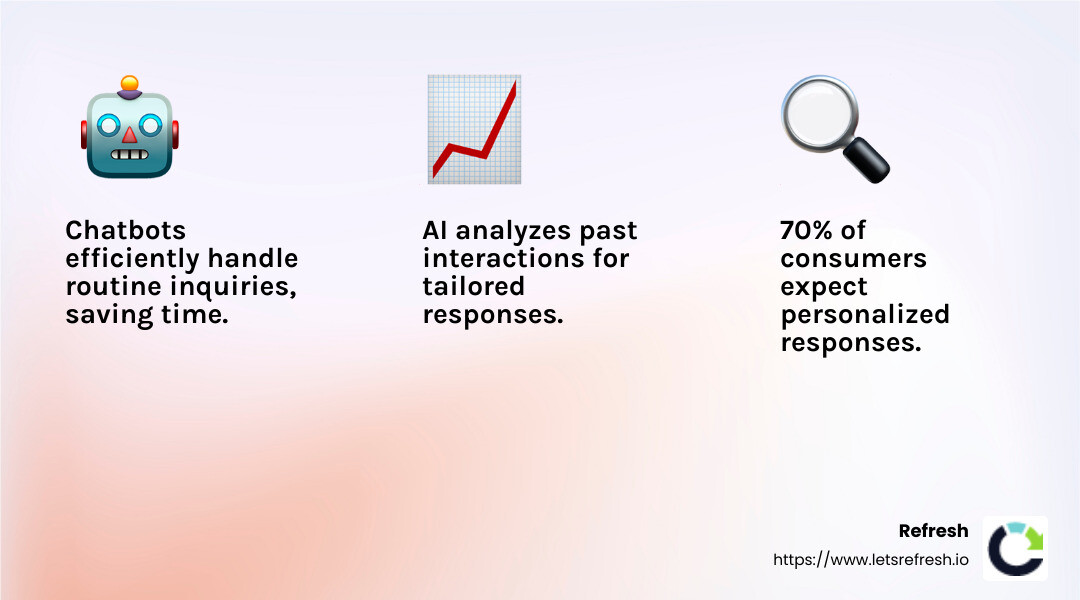July 24, 2025
Social media management trends are shaping the future of digital engagement, offering exciting opportunities but also demanding a sharp focus to leverage these effectively. If you're curious about the trends impacting this space, consider these key points:
- AI Integration: AI tools are becoming vital for handling routine tasks, personalized customer care, and content creation.
- Video Content Boom: Short-form and long-form videos continue to surge in popularity across platforms like TikTok and Instagram.
- Community Over Followers: Prioritizing building communities instead of just gaining followers.
- Platform Focus: Brands are selectively investing resources into platforms that deliver high ROI, rather than spreading thin across many.
- Transparency and Authenticity: Expected by consumers, forcing businesses to be more genuine in interactions.
As we steer this digital age, the importance of social media management cannot be understated. It's not just about posting updates or sharing content; it’s about forging connections, fostering communities, and building trust with audiences. With the landscape continuously evolving—new tools, platforms, and user expectations—staying informed is key to success.
I'm Alexander Palmiere. As the CEO of Refresh Digital Strategy, my experience in social media management trends encompasses helping countless small and mid-sized businesses thrive. From SEO to digital strategy, my passion is delivering results that bolster online presence and engagement.

Important Social media management trends terms:
The Rise of AI in Social Media Management
AI for Customer Service
AI is changing customer service on social media. Chatbots are now capable of handling routine inquiries efficiently, providing quick and accurate responses. This shift not only saves time but also improves customer satisfaction. According to a report, 70% of consumers expect personalized responses, and AI makes this possible by analyzing past interactions and tailoring responses accordingly.

AI-driven insights allow businesses to understand customer preferences better. By analyzing data, AI can predict issues before they arise, leading to proactive customer service. This proactive approach not only resolves problems faster but also builds stronger customer relationships.
However, the rise of AI in customer service isn't without challenges. AI ethics is a crucial consideration. It's important for companies to ensure transparency and fairness in AI interactions. Users should be informed about how their data is used, and they should have the choice to opt out if they wish.
AI for Content Creation
AI is not just revolutionizing customer service; it's also changing how content is created. Generative AI tools, like ChatGPT, are being used to craft engaging social media copy quickly and efficiently. This saves time and resources, allowing marketers to focus on strategic tasks.
AI tools also offer personalized content recommendations. By analyzing user behavior, AI suggests content that resonates with the audience, increasing engagement. This personalized approach is crucial as it aligns with the consumer's expectation of custom experiences.
Several AI tools are available for content creation. For instance, Synthesia uses AI to create personalized videos at scale, while Lexica generates images from natural language descriptions. These tools enable marketers to produce diverse content formats, enhancing brand visibility.
Despite these advancements, there's a concern about the authenticity of AI-generated content. It's essential to balance efficiency with creativity to maintain a genuine brand voice. As AI continues to evolve, marketers must use these tools ethically, ensuring that content remains authentic and relatable.
In summary, AI is a powerful ally in social media management. It streamlines customer service and content creation, offering personalized experiences that consumers now demand. However, ethical considerations are paramount to ensure that AI improves rather than detracts from the user experience.
Next, we'll dig into the Video Content Dominance and explore how short-form and long-form videos are shaping the future of social media.
Video Content Dominance
Video content continues to dominate the social media landscape, with both short-form and long-form formats playing pivotal roles. As we explore these trends, it's clear that short-form video remains a powerhouse, but long-form video is making a notable resurgence.
Short-Form Video
Short-form video is the reigning champion of social media engagement. Platforms like TikTok, Instagram Reels, and YouTube Shorts have made it easier than ever for brands to connect with audiences quickly and effectively. According to a survey, 71% of marketers find short-form videos deliver the highest ROI. This format is perfect for capturing attention with bite-sized, engaging content.
- TikTok: Known for its viral challenges and creative content, TikTok has set the standard for short-form video. With its algorithm-driven "For You Page" (FYP), users can find content custom to their interests, making it a key platform for brand visibility.
- Instagram Reels: Reels offer a way for brands to reach new audiences by leveraging Instagram's extensive user base. The platform encourages creativity with various editing tools, allowing for engaging and visually appealing content.
- YouTube Shorts: While YouTube is traditionally known for long-form content, its Shorts feature is gaining traction. With more than 50 billion daily views, Shorts provides another avenue for brands to engage with audiences in a quick, impactful way.
Long-Form Video
While short-form video is crucial, long-form content is experiencing a revival, offering opportunities for storytelling and deeper engagement.
- TikTok's 30-Minute Uploads: TikTok is experimenting with longer videos, allowing creators to tell more comprehensive stories. This shift reflects users' interest in more in-depth content, and brands can leverage this by creating narratives that resonate with their audience.
- YouTube: As a platform that caters to all demographics, YouTube remains a stronghold for long-form content. It allows brands to develop evergreen content that can be found through search, providing ongoing value and engagement.
- Storytelling: Long-form videos enable brands to engage in storytelling, building emotional connections with viewers. This approach can improve brand loyalty and provide a richer experience for the audience.
In conclusion, both short-form and long-form videos are essential components of a successful social media strategy. Brands should continue to harness the power of short-form videos for quick engagement while exploring long-form content for storytelling and deeper connections.
Next, we'll explore the Social Commerce Expansion and how in-app shopping and live shopping events are changing the way consumers interact with brands on social media.
Social Commerce Expansion
As social media platforms evolve, social commerce is becoming a key player in reshaping consumer shopping experiences. With features like in-app shopping and live shopping events, platforms are not just connecting people—they're changing how we buy and sell.
In-App Shopping Features
In-app shopping is no longer a novelty; it's a necessity for brands looking to capture the attention of a digital-savvy audience. Platforms like TikTok, Instagram, and Facebook have integrated shopping features that make it seamless for users to find and purchase products without leaving the app.
- TikTok Shop: TikTok is leveraging its massive user base to transform the app into a shopping destination. With features that allow brands to showcase products directly within videos, users can easily purchase items they see in their favorite TikToks. This integration creates a smooth transition from content consumption to shopping.
- Instagram Shops: Instagram has been at the forefront of social commerce with its shop feature. Brands can set up virtual storefronts, where users can browse products, view prices, and make purchases directly through the app. Instagram's visual nature makes it an ideal platform for showcasing products, especially in the fashion and beauty industries.
- Facebook Marketplace: Known for its community-driven approach, Facebook Marketplace allows users to buy and sell items locally. It's a powerful tool for small businesses and individuals looking to reach a broader audience. With billions of users worldwide, Facebook Marketplace offers vast potential for expanding a brand's reach.
Live Shopping Events
Live shopping events are taking consumer engagement to a new level by combining entertainment with instant purchasing opportunities. These events create an interactive and dynamic shopping experience, making it easier for brands to connect with their audience.
- Interactive Shopping: Platforms like Instagram and TikTok host live shopping events where influencers or brand representatives showcase products in real-time. Viewers can ask questions, see demonstrations, and purchase products instantly. This format not only boosts sales but also improves consumer trust through transparency and direct interaction.
- Consumer Engagement: Live shopping events are more than just sales pitches; they are engaging experiences that build a sense of community. By using live video, brands can create a personal connection with their audience, encouraging loyalty and repeat purchases.
- Platform Examples: Companies like Amazon have also ventured into live shopping with Amazon Live, where hosts demonstrate products and offer exclusive deals. This trend is expected to grow as more brands recognize the potential of live, interactive shopping to drive sales and engagement.
The rise of social commerce is undeniable. As platforms continue to innovate, brands must adapt to these changes to remain competitive. The integration of in-app shopping and live shopping events offers new ways to engage consumers and drive sales.
Next, we'll dive into how authentic and transparent content is crucial for building trust and connections with today's consumers.
Authentic and Transparent Content
In the world of social media, authenticity and transparency have emerged as key drivers of consumer trust and engagement. As audiences become more discerning, brands are shifting towards content that feels genuine and relatable.
Authentic Content
In a landscape dominated by polished marketing, there is a growing demand for content that feels real and unscripted. According to the Sprout Social Index, 68% of consumers say that authentic and relatable content is more important than high-quality, polished content. This shift is largely credited to the creator economy, where influencers and everyday users create content that resonates on a personal level.
One strategy brands are adopting is employee advocacy. By showcasing the people behind the brand, companies can humanize their image and create a more personal connection with their audience. Sam Mackowitz from Flywire notes that content featuring employees often performs best, as it highlights the authentic voices within the company.
Additionally, user-generated content (UGC) has proven to be a powerful tool. Consumers trust reviews and UGC significantly more than traditional marketing, making it essential for brands to encourage and leverage content created by their users.
Transparency in Business Practices
Transparency goes hand-in-hand with authenticity. Today's consumers are not only interested in the product but also in the values and practices of the companies they support. The Sprout Social Index found that consumers desire more transparency about business practices and values.
Brands like Nisolo are leading the way by providing detailed insights into their sustainability efforts with initiatives like sustainability report cards. This level of openness can foster consumer trust and loyalty.
Incorporating behind-the-scenes content is another effective strategy. By offering a glimpse into the inner workings of your business, you can build a deeper connection with your audience. Whether it's showing how products are made or sharing the stories of your team, this approach can improve your brand's relatability and transparency.
As we move into 2024, brands that prioritize authentic and transparent content will likely find themselves better positioned to build lasting relationships with their audience. Next, we will explore the evolving landscape of social media management trends and how they are shaping the future of digital marketing.
Social Media Management Trends for 2024
As we step into 2024, the landscape of social media management is evolving rapidly. Brands and businesses are increasingly recognizing the importance of staying ahead of the curve to maintain a competitive edge.
Market Growth
The social media management market is experiencing robust growth, driven by the increasing need for businesses to engage with their audiences effectively. The global market is ready to expand significantly, with a projected compound annual growth rate (CAGR) of over 20% in the coming years. This growth is fueled by the rising adoption of social media platforms for marketing and customer engagement.
Evolving Social Teams
With the growth of the market, social media teams within organizations are also evolving. New roles are emerging, focusing on specialized skills that cater to the dynamic needs of social media management. For instance, roles like social media data analysts and community engagement specialists are becoming more prevalent. These roles require a blend of analytical skills and creativity to effectively manage and engage with online communities.
The structure of social teams is also changing. Companies are moving towards a more integrated approach, where social media teams collaborate closely with other departments like marketing, sales, and customer service. This integration allows for a more cohesive strategy that leverages social media insights across the organization.
Data-Driven Strategies
In 2024, data-driven strategies are at the forefront of social media management. The ability to harness social data effectively can provide valuable insights that inform decision-making across departments. According to recent research, 76% of marketers agree that social insights are crucial for informing strategies beyond the marketing team.
Social media data can significantly improve ROI measurement by providing detailed analytics on engagement, reach, and conversion rates. This data-driven approach enables businesses to optimize their social media strategies for better performance and allocate resources more efficiently.
Moreover, the integration of cross-department insights ensures that social media data is not siloed within the marketing team but is used to benefit the entire organization. This holistic approach can lead to improved product development, improved customer support, and more effective public relations strategies.
As social media continues to play a pivotal role in business strategy, embracing these trends will be crucial for companies aiming to thrive in the digital age. Up next, we'll dig into the frequently asked questions surrounding social media management trends and explore the future trajectory of this dynamic field.
Frequently Asked Questions about Social Media Management Trends
What are the biggest trends in social media right now?
In 2024, several social media management trends are taking center stage. AI is revolutionizing how brands interact with their audiences. From chatbots that offer personalized customer care to AI-driven content recommendations, artificial intelligence is streamlining operations and enhancing user experiences.
Short-form video content is another major trend. Platforms like TikTok, Instagram Reels, and YouTube Shorts are leading the charge, offering high ROI and engaging younger audiences with bite-sized, entertaining content.
Authentic content is also gaining traction. Consumers are craving genuine interactions and transparency from brands. This shift is pushing companies to showcase behind-the-scenes content and promote their core values openly.
Is social media management growing?
Yes, the social media management market is experiencing significant growth. With businesses increasingly relying on social media for marketing, customer service, and community building, the market is projected to grow at a compound annual growth rate (CAGR) of over 20%. This expansion is driven by the demand for effective engagement strategies and the need for specialized roles within social teams.
The rise of data-driven strategies is also contributing to this growth. Companies are leveraging social media data to improve ROI measurement, optimize content, and improve cross-department collaboration.
What are the future trends for social media marketing?
Looking ahead, several trends are expected to shape the future of social media marketing. Short-form video content will continue to dominate, with platforms like TikTok and Instagram leading the way. As consumers gravitate towards quick, engaging content, brands will need to adapt their strategies accordingly.
The emphasis on authentic content will persist, with brands focusing on transparency and building trust with their audiences. This approach not only improves engagement but also fosters loyalty among consumers.
Instagram is anticipated to remain a top platform for ROI, offering robust marketing tools and a strong user base. However, it's important for brands to keep an eye on emerging platforms and trends to stay competitive.
Lastly, data-driven budgets will become more prevalent. With the ability to track detailed analytics and social insights, companies can allocate resources more efficiently and optimize their strategies for maximum impact.
As the social media landscape continues to evolve, staying informed about these trends will be essential for businesses aiming to succeed in the digital age.
Conclusion
As we look ahead, the landscape of social media management is set to evolve dramatically. The trends we've explored, from AI integration to the dominance of short-form video, underscore the dynamic nature of this field. Businesses that adapt to these changes will not only engage their audiences more effectively but also drive greater returns on their social media investments.
Refresh stands at the forefront of these developments, offering comprehensive digital marketing solutions custom to the unique needs of small to medium-sized businesses. Our expertise in social media management, coupled with our focus on long-term partnerships, positions us to help clients steer this ever-changing environment.
We are committed to leveraging AI and other emerging technologies to improve customer interactions and streamline content creation. Our approach ensures that businesses can maintain authentic and transparent relationships with their audiences, building trust and loyalty in the process.
Looking to the future, social media management will continue to grow in importance. As platforms introduce new features and consumer preferences shift, staying informed and agile will be crucial. By embracing data-driven strategies and fostering specialized skills within social teams, businesses can optimize their social media efforts and achieve sustainable growth.
At Refresh, we're excited to be part of this journey, helping our clients thrive in the digital age. To learn more about how we can support your social media strategy, visit our service page and find the possibilities.
Still have questions? Let’s talk about it.
.avif)





